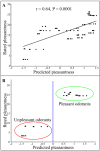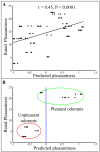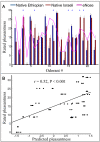Predicting odor pleasantness with an electronic nose
- PMID: 20418961
- PMCID: PMC2855315
- DOI: 10.1371/journal.pcbi.1000740
Predicting odor pleasantness with an electronic nose
Abstract
A primary goal for artificial nose (eNose) technology is to report perceptual qualities of novel odors. Currently, however, eNoses primarily detect and discriminate between odorants they previously "learned". We tuned an eNose to human odor pleasantness estimates. We then used the eNose to predict the pleasantness of novel odorants, and tested these predictions in naïve subjects who had not participated in the tuning procedure. We found that our apparatus generated odorant pleasantness ratings with above 80% similarity to average human ratings, and with above 90% accuracy at discriminating between categorically pleasant or unpleasant odorants. Similar results were obtained in two cultures, native Israeli and native Ethiopian, without retuning of the apparatus. These findings suggest that unlike in vision and audition, in olfaction there is a systematic predictable link between stimulus structure and stimulus pleasantness. This goes in contrast to the popular notion that odorant pleasantness is completely subjective, and may provide a new method for odor screening and environmental monitoring, as well as a critical building block for digital transmission of smell.
Conflict of interest statement
The Weizmann Institute has filed a patent on “predicting odorant pleasantness with an electronic nose” as described in this manuscript.
Figures





References
-
- Dravnieks A. Approaches to objective olfactometry. In: Tanyolac N, editor. Theories of odors and odor measurement. Istanbul: Robert Coll Res. Center; 1968. pp. 371–408.
-
- Persaud K, Dodd G. Analysis of discrimination mechanisms in the mammalian olfactory system using a model nose. Nature. 1982;299:352–355. - PubMed
-
- Gardner JW, Bartlett PN. Electronic noses. Principles and applications. Measurement Science and Technology. 2000;11:1087.
-
- Pearce TC, Schiffman S, Nagle HT, Gardner JW, editors. Handbook of machine. Olfaction: Wiley; 2003.
-
- Albert KJ, Lewis NS, Schauer CL, Sotzing GA, Stitzel SE, et al. Cross-reactive chemical sensor arrays. Chemical Reviews. 2000;100:2595–2626. - PubMed
Publication types
MeSH terms
Substances
LinkOut - more resources
Full Text Sources
Other Literature Sources

